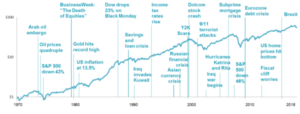
As we publish this article, over 70,000 have been diagnosed with the virus named “Covid-19”and over a thousand people have died. While these statistics are significant, they pale in comparison to the seasonal flu, which has contributed to fifty times as many deaths in recent years. What distinguishes Covid-19 from the seasonal flu is that it is more contagious and deadlier.
Covid-19 was first identified in December of 2019, and it is still too early to determine how severe the virus will be. Since there is no immunization available, anyone potentially exposed to the virus is isolated for two weeks to limit contagion. This means that there is almost no travel into or out of the region around the city of Wuhan, China, where it was discovered. Wuhan is a major manufacturing region and a population center roughly equal to New York and L.A. combined. International travel to and from China also has been limited. While recent statistics indicate that the spread of the virus may be slowing, the virus is not yet contained.
The difficulty in assessing the impact of new viruses
While epidemiologists study the virus, economists and investment professionals try to determine its financial impact. It has now been a month since the quarantine of Wuhan was imposed on January 23rd. Businesses in China are gradually starting up again but at low staffing levels since many workers are hesitant to return from visiting families for the Lunar New Year Holiday. The most recent epidemic to originate in China was SARS in 2002 and 2003. At that time, China represented a much smaller share of global economic activity and its production capabilities much less integrated with those of other countries. Today, China’s economy is roughly equivalent in size to that of the U.S., and many products sold worldwide include components from or final assembly in China. Therefore, comparing the economic impact of Covid-19 to historical epidemics is difficult.
We live in a very interdependent world. Apple iPhones include parts manufactured in Texas, South Korea, the Netherlands, and Taiwan which ship to China for final assembly then are sent to consumers worldwide. Over the past decade, many firms have established manufacturing processes spread across the world in pursuit of lower costs. They have chosen to store very little excess inventory at each step of production. These decisions have reduced costs but also flexibility, increasing the risk that a small supply disruption may lead to a material economic impact.
Many factors make it difficult to assess the economic repercussions of Covid-19. However, in the next sections, we explore two potential outcomes: limited economic impact versus a greater impact than anticipated.
The rationale as to why the long-term economic impact may be minor
There is a case to be made that the economic impact of the Covid-19 virus will be limited. The Chinese Government is encouraging companies to resume operations. Travel restrictions within China are gradually ending, and life in China for those not infected should return to normal in a couple of weeks. Once the spread of Covid-19 has stopped, countries will quickly end their travel bans, particularly those eager to do business with China or benefit from Chinese tourists.
If Chinese consumers quickly replace any delayed spending, overall domestic production and consumption may approach levels originally projected for the full year of 2020. A lost month has a big impact on the first quarter, but less so when measured over a full year. Chinese companies may be able to catch up with all contracted production for 2020. No doubt, some sectors will be hit hard. Companies relying on Chinese tourism will have a weak 2020. Local farmers who could not feed their animals or sell their perishables will seek assistance. So will hourly workers who have lost a month of wages.
The Chinese Government has already mitigated some of the stresses on the financial system by injecting money and limiting speculation. A strong argument for only limited economic impact is that President Xi Jinping will do what is required to maintain China’s growth, political stability, and global influence. Over time, one or two months of economic growth lost will be hard to notice when measured over a decade.
The case that the economic impact is still to come
Financial markets are pretty efficient at pricing known risks. In most situations, returns are related to the risks taken. This relationship breaks down when a rare event occurs and the economic impact has no precedent. During January and the first three weeks of February, global financial markets did not expect a material impact on corporate earnings from the Covid-19 virus. On Monday, February 24, stock markets dropped- an example of the market digesting new information and repricing, and an indication that investors may have underestimated the economic costs.
One reason is that the world’s economies are more interconnected than ever. Manufacturers do not have a clear understanding of whether the suppliers to their suppliers are in China. Fewer purchases by the Chinese of raw materials from Australia and Brazil, or fewer cars from Germany and Japan may nudge those economies into a recession. Starbucks lattes not purchased last month will not become additional latte purchases next month.
Another danger might be that the Chinese Government’s slow response may lead to political instability. China’s economy relies on a political system that promises the people stable economic growth in exchange for relinquishing personal freedoms such as free speech. The Wuhan doctor, Li Wenliang, tried in December to communicate the potential danger through social media but was initially censored. News reports from China have identified growing frustration of the Government’s slow reaction to initial reports of the virus. While unlikely, a loss of confidence in the political system could create instability in this major economy.
In times of uncertainty, avoid concentration and use time to your advantage
A deadly contagious virus is not a new risk. Investors always face the risk of rare events such as war, hurricanes, financial market crashes, and pandemics. While few may have had the foresight to predict both the timing and impact, there are many who will claim after the fact that the impact of the event was obvious.
The Covid-19 virus will generate similar stories of prescient investors claiming to have generated returns through market timing or stock selection. Most will simply be due to luck.
No one truly knows the extent of the financial impact of the quarantine or the possibility of political instability. It may slow the global economy in the first half of 2020. It may nudge Europe or Japan into a recession later this year. We don’t know. The best investment strategy in the face of this uncertainty is to avoid concentrating your investments in specific sectors or financial markets.
The following graph from Dimensional Fund Advisors provides an important reminder of the value to long-term investors of sticking to their strategy through crises. The line represents an investment in the global equity markets starting in 1970. Staying the course increased wealth by more than fifty times (the vertical scale is exponential, not linear) over forty-nine years of crises.
Source: Dimensional Fund Advisors. In US Dollars. MSCI data © MSCI 2019, all rights reserved. Indices are not available for direct investment. Their performance does not reflect the expenses associated with the management of an actual portfolio. Past Performance is no guarantee of future results.
Economies and financial markets go through cycles. While it is hard to predict the timing and extent of each recession, we know that it will come and it will pass. To benefit financially, investors with long-term goals should 1) have an accurate assessment of their emotional tolerance for stock market drops and 2) maintain sufficient high-quality fixed income investments to avoid the need to sell during a decline. Do both, and financial wealth will be immunized from catching coronavirus.
